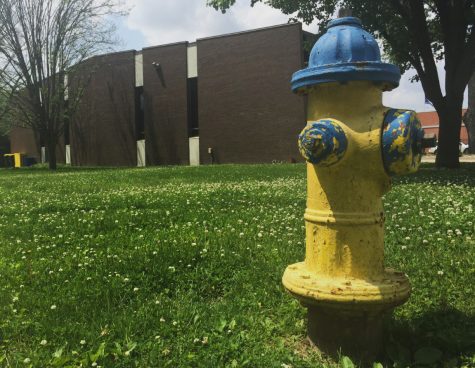CFD testing quality of fire hydrants in June
May 28, 2019

A fire hydrant outside the Charleston Fire Department Station 2 building. Fire chief Steve Bennett said the best fire hydrants have caps that are painted blue like this one. He said they produce upwards of 1,500 gallons of water per minute.
The Charleston Fire Department is testing the city’s fire hydrants in June, and this testing is important because it affects everyone’s insurance premiums and safety.
Fire chief Steve Bennett said the International Organization for Standardization (ISO) analyzes data from fire departments in the U.S. and assigns them fire suppression ratings.
On a scale of 1-10, with 1 being the best and 10 being the worst, ISO uses these rankings to determine if fire departments meet its minimum criteria, according to Verisk’s website. This information is then used to calculate insurance premiums.
Generally, insurance costs “substantially lower” in communities with better ratings than in communities with poorer ratings, according to the website.
Bennett said the CFD sits at a 2 overall.
The ratings affect entire communities, so they may result in either more or less businesses moving into the city in question, depending on the rating, he said. Businesses are likely to choose communities with good ratings because that ends up saving them money.
Bennett said every three years, the CFD conducts flow tests on the fire hydrants in the city to make sure they are all working properly and to accumulate data for the ratings.
Different gauges are used to record the pressure of the flow of each fire hydrant. The CFD sends this information to the National Fire Protection Agency (NFPA) to determine how many gallons of water will flow out of each hydrant per minute, he said.
This is why fire hydrants in the city have different colored caps, Bennett said. Hydrants with blue caps pump upwards of 1,500 gallons per minute, hydrants with green caps pump 1,000-1,500 gallons per minute, hydrants with orange caps pump 500-999 gallons per minute and hydrants with black caps are out of service.
Out of about 800 fire hydrants in the city, most of Charleston’s have blue caps, he said.
If the CFD finds any damaged fire hydrants, it contacts the Utilities Department to determine what exactly the damages are and what needs to be done to repair them. The Utilities Department takes it from there, he said.
Besides affecting the community’s insurance premiums, the testing is necessary to ensure every fire hydrant is in working order in case of any fires, he said.
The tests may result in some discolored water, Bennett said. This happens because some areas of waters have been stagnant for long periods of time, which is where the “rusty” water color comes in, he said.
Flushing the water a couple times should bring its normal color back, Bennett said.
The fire hydrant testing should be complete by the end of June, and Bennett said there are a couple things members in the community can do to make the process easier and quicker for the CFD.
He said first and foremost, it is crucial for people to keep fire hydrants visible for the CFD.
“The biggest thing is visibility. If you’re driving down the road and you can’t see that fire hydrant, (the CFD is) not going to be able to see it—especially at nighttime,” he said. “If your house is on fire, I think you probably want us to know where that fire hydrant is as soon as possible.”
People should keep weeds down, remove any objects in the way of the fire hydrants and refrain from ever parking in front of them, he said.
Logan Raschke can be reached at 581-2812 or at lrraschke@eiu.edu.



































































